|
FAQs about Propagation/Reproduction of
Caryophyllid Corals
Related Articles:
Caryophyllid Corals, Elegance Coral,
Related FAQs: Elegance Coral Reproduction, Caryophyllids 1, Caryophyllids 2, Caryophyllids 3, Caryophyllids 4, Caryophyllid ID, Caryophyllid Compatibility, Caryophyllid Systems, Caryophyllid Selection, Caryophyllid Behavior, Caryophyllid Feeding, Caryophyllid Disease, Stony/True Coral, Coral System Set-Up, Coral System Lighting, Stony Coral Identification, Stony Coral Selection, Coral Placement, Foods/Feeding/Nutrition, Disease/Health, Propagation, Growing Reef Corals, Stony Coral Behavior,
|
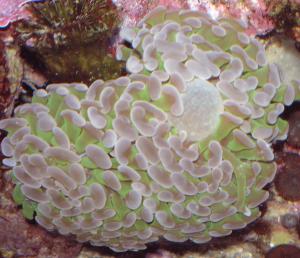
|
|
Hammer Spawning?
7/8/15
Hi Bob,
We suddenly saw several bright green rice size
<Rice size? A bit large>
things in our tank this morning, at first I thought our green hammer was getting
munched on.
However upon closer inspection these things look like little green kidney bean
shaped pods with a small root like thing protruding from them in the middle. I
attached a picture.
Was the hammer colony spawning?
<Maybe; do you have a microscope to take a bit closer look?>
Thanks do much for your thoughts
Nish
<Could be planula from coral. Neato! Bob Fenner>
Re: Hammer Spawning?
No microscope i am afraid.....what are planula?
<See.... the Net? B>
|
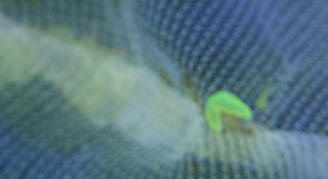 |
|
corals ejecting pearl-like material 1/1/13
Hello and happy new year!
I have a new Euphyllia Glabrescens in a 10 gallon quarantine tank for the
past week. It’s under a 96W power compact light. Yesterday evening when
leaving for some new year’s festivities, I noticed both polyps with mouths
gaping huge, releasing strings of wispy mucous with dozens of white, tiny
pearl-like particles into the water. Looking into the mouths, I could see
dozens more of these particles inside the polyps, as can be seen in the
photos. I placed a bag of carbon, but being on my way out didn’t have time
to do a water change thinking I would do it this morning. However today the
coral looks absolutely normal with no signs of what it ejected anywhere in
the tank. Either it broke down in the water, or the coral retracted it!?
Now I have in the past seen various corals release brown waste/perhaps
Zooxanthellae, and other times mesenteric filaments, and video footage of
coral spawning. This doesn’t seem like any of those, and as far as I know
corals are not egg layers, so what do you think this is?
Thank You
Dave
<Mmm, yes; stress-induced release of planulae... Do search on Google or such
with the string "stony coral ejecting planulae". Bob Fenner>
|
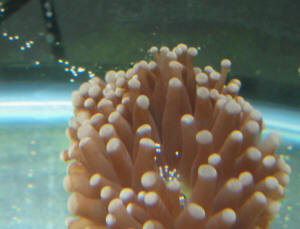
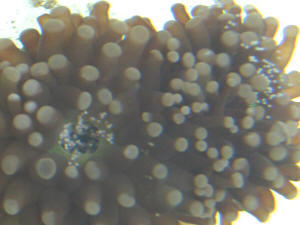 |
Re: corals ejecting pearl-like material
1/1/13
Thanks so much, Bob!
Funny, I had tried searching but found no explanation, and didn't think this
was a reproductive event because these particles were too large to be
gametes.
<Mmm, well, eggs are big/ger, not spermatozoa though>
Now, searching the term "planulae" there is lots of info to read!
Interesting that E. Glabrescens is hermaphroditic and can eject planulae
while the other Euphyllia species broadcast gametes. Learn something
everyday, Thanks again!
<Ah, welcome. BobF> |
|
Baby Euphyllia 11/8/10
Hi Crew,
<Samuel>
Just wanted to share this with you. I had a hammer that had tiny
little babies coming out of the branches.
<Neat!>
They never seemed to take off and grow. And if I move them and
ended up touching the baby it usually died. Anyway, the one
pictured did start growing after the head died. You can see that
it is coming out perpendicular to the branch. Sam
<Thank you for sharing. BobF>
|
|
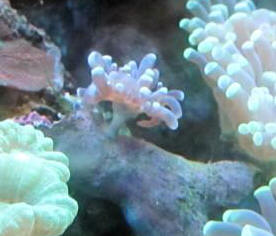
|
|
Torch Coral Reproduction 7/27/10
Greetings Crew,
<Hi Joe>
Thanks again for sharing your wisdom- it is a true blessing!
<To be shared>
I have a Torch Coral that has been doing very well and today, I
witnessed what I believe to be a reproductive event. While I
write, the coral is continuing to spew a milky substance into the
water (it looks similar to the alkalinity component to B-ionic).
This has been occurring for at least an hour so far. As you can
see in the attached pic, the coral has about a dozen heads, 7 of
which are retracted. Unfortunately, I was unable to get an action
photo of the liquid discharging. At first I thought that the
coral may be expelling zooxanthellae but from what I've
studied, this usually comes from the tentacles. The liquid is
clearly leaving the mouths, sometimes occurring simultaneously
between various heads. My Midas Blenny is particular, seems to be
interested in the
spectacle, probably consuming what it can catch. It does not
appear to be nipping at the polyps but rather eating from the
water column.
In your experience, is Euphyllia reproduction common in the
aquarium?
<Mmm, not uncommon, but usually not witnessed>
Is it normal for polyps to retract during these events or is this
indicative of a problem with the coral?
<Not a problem>
No other tank specimens seem to be effected.
Thank you!!
Joe W.
<I recall your next email... Bob Fenner>
Torch Coral Reproduction 2
Dear Crew,
<J>
After sending my initial email, I checked the dailies and noticed
another Torch Coral spawning post! What a coincidence! Do you
think that the this may be a seasonal issue?
<Mmm, likely not in captivity, and I did read over the
Euphylliid, older name Caryophyllid reproduction FAQs, in which
there are 'some other mo.s' in which these events have
been observed>
It would be interesting to do a study on when and why corals of
specific species spawn in captivity.
<Mmm, me too... stress? "Lunar" cyclicity? Some
other inputs like temperature, water change aspects of some
sort?>
Thanks!
Joe W.
<Thank you, BobF>
|
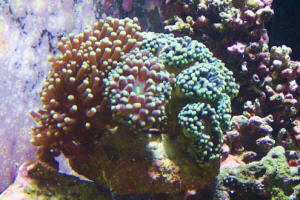 |
|
I think my torch coral spawned. 3/13/10
<... we ask folks to limit their attachments to a few hundred
Kbytes...
you've sent along some ten Megs... Is there a full moon where
you are?>
I think my torch coral spawned but I can't be sure as I have
never seen anything like this before. Can someone please confirm
that this is what's happened and if so what I can do to keep
the little guys alive? Most have attached themselves to various
rocks and structures in my reef tank and I would like to see a
few make it.
<Looks more like it's egesting... defecating...
"going potty"... Coelenterates (old name) only have one
opening... serves for all purposes. Read here:
http://wetwebmedia.com/carypropfaqs.htm
Sexual reproduction in Euphylliids/Caryophylliids is rare in
captivity...
and looks different... the gametes being larger and smaller than
what's pictured here.
Bob Fenner>
|
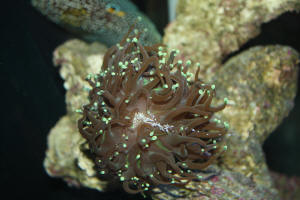 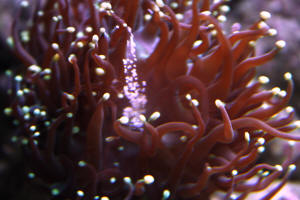 |
Re: I think my torch coral spawned.
3/13/10
I have had this torch coral for 3 years now, I have watched it
"potty" many times. It's always brown and small it
has never released anything like this before. This is the first
time I see hundreds of different sized white balls be released in
mucus strands and place themselves randomly around my tank. We
don't have a full moon right now. We are in our new moon stage
where I am. Hope this helps.
<Mmm, still not reproductive behavior as far as I know. Have
seen Euphyllias reproducing in the wild... this is something else.
BobF> |
Time to grow up on your own? Euphyllia prop.
4/4/09
Hello there! I have a branching hammer coral that had three heads; one
was damaged as the LFS clumsily bagged it.
Needless to say, that damaged head disintegrated despite my best
efforts to provide it a good environment. However, the remaining heads
are flourishing and I left the skeleton of the "dead" one as
I know sometimes polyps can appear on them again.
<Yes>
Anyway, at the base of this hammer coral is a small polyp with a stony
tube--a baby hammer from the looks of it. It's about quarter of a
inch long and maybe 2-3 millimeters in diameter. I've read that
these may perish
in the shadow of the parent colony, so they should be removed in
time.
<Mmm, with Euphylliids in captivity, some other stony coral
families, this isn't really such a big issue... Can/do derive
enough nutrition from
feeding, photosynthesis almost always...>
I tried to look up what size is safe to break this guy off before that
happens but didn't find anything specific. Any suggestions?
<The last segment of your thumb is about right>
Stats as follows:
24 gallon JBJ DX
<Mmm>
32.5# Live Rock
40# pink Fiji sand
108 watts compact fluorescent lighting (1 actinic, 2 50/50)
Temperature 78-81
SG 1.0255
ammonia
0
nitrite 0
nitrate 10 ppm
pH 8.2
Calcium 480 ppm
<Too high>
There is a Koralia 1 power head
in the display and a maxi 1200 for the return pump for flow.
Small piece of poly filter in chamber 1.
Chaetomorpha and live rock rubble in chamber 2.
100w heater in chamber 3.
10% water change weekly (switching to 20% bi-weekly a OK?)
Dose 2 part b-ionic once a day for a 10 gallon volume.
livestock:
1 pearly jaw (loves Cyclops and the pods in the tank, nothing
else...)
1 small serpent banded starfish
1 cleaner shrimp
2 orange Astreas
2 star Astreas
4 Nassarius snails
1 blue knuckled hermit crab
2 blue legged hermit crab.?
Thank you again for your time! :)
Danny N.
Tampa, FL
<Welcome. Bob Fenner>
Vacation = partial frogspawn polyp bailout
1/10/09 Hello, I am back again for some more of that wonderful
WetWebMedia insight. I was out of town for Christmas and new years and
when I came back there was an issue with my frogspawn. I had a neighbor
dispense premeasured food cups every few days so I know there was no
overfeeding. <Good move> The day before I left I was getting the
auto top off ready. I usually have a 5 gallon reservoir but for this
trip I needed a larger one. My water filter broke that night (of
course) so I had to use tap water, I know I know but what could I do.
Most of the water I used came from jugs I keep in my garage that were a
few months old. I figured the aged water would be better. I added
Seachem PRIME to help as much as possible. My local water is not too
bad but it is still tap water. Well on to the issue. My frog spawn had
5 large heads, well 3 of the heads have recently split and there are a
bunch of tiny new sprouts so the are really 9 and some change but its
on 5 large branches. When I got back from vacation one of the heads was
gone totally. I found it in the tank floating around fully intact.
<Mmm, not floating?> A day later another head detached. The flesh
on the remaining large heads have receded up the branch (hope that
makes sense) but the heads are still intact. The two detached heads are
now in a glass with some broken shells on the bottom of my tank.
<Very shallow glasses I hope... better some shallow plastic tubs...
even cut-down margarine type containers> I was hoping for some
insight to why this happened and to see what would the be the best
thing to do with the detached heads. <Mmm, something triggered their
breaking away... the new water perhaps as you hint, maybe some sort of
"warfare" twixt the Euphylliid and other Cnidarian here... I
would "do" with them as you have... see if they'll
recover> My water params are about what they are normally but I am
sure there is something in the tap I do not test for. I have read they
can reform a calcium skeleton. I also know they may have bailed out due
to water issues. Is there a good way to try to attach them to
something. <A few, but best to leave as you have done for a few
months for now> My other corals are doing fine. I have a fox coral,
some soft corals, some Zoa's, and some gorg.s. <Mmm> There
was nothing very close so I do not think it was chemical warfare.
<Don't have to be close for chemical... just physical
warfare> I do water changes of about 10 gallons about every two
weeks. Thanks for you insight and suggestions. Jeff I use API test kits
72 gal bow with 20 gal long sump containing 8 gallon refugium specific
gravity 1.024 ammonia- borderline 0 nitrate- 0 nitrite- 20 (I think it
is in ppm) I can not seem to get this down ,any suggestions? I have
tried sugar/vodka method but gave up, and I just got a new RO/DI a
couple days ago. ph- 8.2 I buffered it to 8.3 as that is where it is
usually at calcium- 520 always stays this high from the salt I use KH-
10 <Jeff, please read here: http://wetwebmedia.com/cnidcompppt.htm
and the linked files above. Bob Fenner>
Hammer coral budding, and more beh. - 06/02/08
Greetings, <Salutations> I have a hammer coral, and there are
several buds on the exposed skeleton. One bud is currently poking out
of the parent tissue. I read that I would have to remove them from the
parent to save them. <Mmm, no... or not necessarily. If desirous of
"speeding up" the process, you can attempt removal, but
otherwise will/do drop off in time of their own accord> What's
the easiest way to do this with minimal risk to the parent colony?
<A sharp metal tool like a chisel...> Wouldn't removing the
buds make the original colony look ugly with holes everywhere?
<Beauty is in the eye, mind...> ? The buds are very tiny, about
3/16" of an inch in diameter.? Will this little thing really grow
with just adequate light and water flow? <If conditions, their
development is sufficient...> Also, while feeding my fish, I noticed
a fully expanded hammer coral tentacle floating about in the water.? I
siphoned it out and put it in my 10 gallon tank on a rock to see if it
will settle. Is this a bad sign? <Is not a good sign or behavior...
can/does sting other sea life... including sessile invertebrates,
fishes... best to remove> Another thing is that my hammer
doesn't seem to be interested in food. I placed some Mysis on its
tentacles, but the coral didn't react. It just let the Mysis float
away. Do I need to put food directly on its mouth, or should I not
worry about feeding it? <I would feed it... read on WWM re:
http://wetwebmedia.com/starfdgfaqs.htm Bob Fenner>
|
Frogspawn spitting out pale pink
"balls" ???- Euphyllia spawning 11/19/07 Hello and
thank you for your website and all the information you provide.
This is a strange question. I recently purchased a green
frogspawn who seems to be happy in its new home. It opens up to
about the size of a softball during the day. Last night I noticed
it spitting out small pale pink balls (for lack of a better
term). <A better term might be "planulae." ;)> I
could not get a good picture and that is the best description I
can come up with. The "balls" float around and
eventually attached to the side of the tank. They move somewhat
like a slug on the glass. <Coooolll!!> The are about the
size of a large pin head. What the heck is this? I am new to
saltwater so I want to make sure it won't hurt the tank. I
have been removing them when I see them but not really sure if I
need to. Any advice is appreciated. <Your coral is releasing
larvae! It's having babies which are apparently attempting to
settle on the glass of your aquarium. I can't even begin to
tell you how uber-cool this is! Please, please, please try to
take pictures (at least of the coral so that maybe we can guess
what species this is). I'm honestly not sure what you should
do with the planulae. I would experiment with them a bit... try
to get them to settle on different things. Some people try to use
tiles of different sorts. You'd be venturing into relatively
uncharted territory here though (very exciting!). Unfortunately,
there's just not a lot of publicly available information on
this. About the most information you'll find about captive
coral larval rearing is here:
http://www.advancedaquarist.com/2006/3/aafeature2 However,
that's for Pocillopora (Euphyllia are likely different).
Please continue to share your experiences with us and do visit
MOFIB (www.mofib.com). Oh, and do run extra activated carbon and
do some generous water changes... spawnings can sometimes spoil
the tank water.> Thanks again. <Thank *you*! Sara
M.>
Re: Frogspawn spitting out pale pink
"balls" ??? -Euphyllia spawning 11/19/07
Ooops...forgot to give you parameters on tank. 14G BioCube,
Nitrite 0, Ammonia 0, PH 8.2-8.4, Nitrate <10, Temp 78,
<This is a bit cool for a reef tank... 80 to 83 would be
better.> Salinity 1.023. <Salinity for a reef tank should
be 1.025 to 1.026.> The tank has been running for 8 weeks.
Inhabitants include 1 bubble coral, frogspawn, button polyps,
hammer coral and candy coral. 17 lbs of LR and 15 lbs of LS.
<Hmm...how big is the Euphyllia? How long as it been in your
tank? Are the afore mentioned parameters stable? There's a
chance this is a "stress spawn" if something has
changed recently.> 1 false percula and just this morning lost
1 false Perc to what we think was Brooklynella but not positive.
My daughter also takes care of the tank and tends to act
"too fast" when trying to solve a problem. Thanks
again. <Please, let me thank you for sharing... your spawning
report/query made my day. :-) -S.M.>
Re: Frogspawn spitting out pale pink "balls" ???
11/19/07 Hi Sara M- The coral has four heads and gets to
about the size of a softball when fully opened. It is really
beautiful. It has only been in the tank for about 2 weeks so it
could be stress. I am going to gradually raise the salinity and
the temperature. The parameters have been the same for 6 weeks.
We do a weekly small water change and lower the nitrates but they
manage to creep back up at the end of the week. I feel like the
"proud mama" of baby frogspawn larva! I'm going to
do my best to get pictures and I'll keep you updated. Thank
you so much! <Thank you for the additional info. It will
certainly be exciting if any of the larva settle. If they do,
keeping them alive and fed will be a whole other ordeal, but will
be a certain learning experience. We look forward to hearing
updates. Good luck! -Sara M.>
Re: Frogspawn spitting out pale pink
"balls" ??? -11/19/07 Hi Sara M- The coral has four
heads and gets to about the size of a softball when fully opened.
It is really beautiful. It has only been in the tank for about 2
weeks so it could be stress. I am going to gradually raise the
salinity and the temperature. The parameters have been the same
for 6 weeks. We do a weekly small water change and lower the
nitrates but they manage to creep back up at the end of the week.
I feel like the "proud mama" of baby frogspawn larva!
I'm going to do my best to get pictures and I'll keep you
updated. Thank you so much! <Oh, I forgot to say... I'm
not sure it was a stress spawn. Usually, it seems that stress
spawns, if they're going to occur at all, occur within a few
days after the coral is moved or after a water change (or some
other change). They don't usually happen 2 weeks later (as
far as I've heard anyway). Where are you? Or, if you
don't want to say, when was the last full moon where you are?
Corals usually spawn either X days after or before a particular
full moon... -Sara M.>
Re: Frogspawn spitting out pale pink
"balls" ??? -11/19/07 We're located in North
Texas. Our next full moon will be on Saturday the 24th. I really
appreciate all the information <Hmmm... interesting.
Unfortunately, I can't find much about exactly when they
spawn except that it's usually annual and in the spring in
the Indo-Pacific (during a particular lunar phase-can't find
the details yet though). Some of the fun part about all this, and
almost a romantic question: does a coral from Indonesia still
"know" where the moon is when it's moved to North
Texas?...or does it follow the Texas moon? There's also the
question of what causes a stress spawn. It's probably
hormonal/biochemical, which might make us wonder... are there
other things that could cause a rise in these hormones? could
diet? presence of other corals? So many questions... so few
answers. So, if it's not too much a bother, you might want to
start keeping an aquarium log and see if this happens again (and
under what circumstances). Thanks again and please do keep in
touch (and keep asking questions if you have them). :-) Best,
Sara M.>
Re: Frogspawn spitting out pale pink
"balls" ??? -11/19/07 We're located in North
Texas. Our next full moon will be on Saturday the 24th. I really
appreciate all the information <Oh, btw, if you're
curious... I added your spawn report to a chart I made of captive
spawning reports for different corals: http://www.asira.org/breedchart1.htm
Best, Sara M.>
|
Bugs inside torch tentacle 11/13/07 Hello, I made
an ill-advised purchase of a torch that was not doing so well at the
LFS. Anyway I have seen what look like little bugs swimming inside the
tentacles themselves. Just little black dots going back and forth
inside the tentacles. It is in a quarantine tank by itself. Just really
strange looking. <EEeeeee! It sounds like it might spawn! :-D Please
try to take some pictures and send them in if you can!! And I would
keep it in quarantine... sometimes coral spawn can really mess up your
water.> Thanks, James <My pleasure! Sara M.>
Damaged Frogspawn ... prop., health 4/25/06 Hi
all, <Debi> Well to make this short and not so sweet. I was
cleaning my tank, 46 bow front salt, changing water etc, when I
stupidly decided to shorten the stem on my very pretty Frogspawn. The
LFS told me I could just break off the end and made it sound simple so
I did, but I had to put more force on it than I expected and when it
broke off it banged it's head (sort of opened up) on a rock and
several little green pieces broke off. <Mmm, best/better by far to
do such "operations" outside the main tank... with the animal
shaken (not stirred?) a few moments ahead to cause the polyps to
retract...> Needless to say, it immediately retracted in shock and I
also retracted from the tank in shock. I had no idea what to do so I
repositioned it in the same place it had been, quickly finished my
tasks and decided to leave it alone, either to die or recover. My
question is whether or not I can do anything else for it (anything
good) aside from leaving it alone. Should I take it out and put it in
the QT tank of which I am not so sure it is ready? <Mmm, I would
not... given just the information presented here. Much more likely to
cause further trouble at this point likely> Should it be dosed with
Iodine and can that be done in the show tank? <This is likely
best> I feel awful, he was so pretty and now he's just all
sucked in and I have no idea if he is beyond repair or not. Thanks
<Euphylliids are very tough if/once established... I give you good
odds of complete recovery. Bob Fenner> Detaching A Euphylliid
From A Rock - 03/16/06 Hi WWM, <<Hey there Tanya!>>
Quick question(s) for you (I hope) - I recently purchased a hammer, but
it came epoxied to a rather large piece of very unattractive lava rock
that I'm having difficulty placing in my 29 gal tank. What's
the best way of removing it so I can reattach it elsewhere? <<Buy
or borrow a hacksaw frame and go to the hardware store/home center and
buy a carbide "grit" blade to fit the saw. These usually come
in two styles...one looks like a heavy wire coated with the grit...the
other looks like a standard hacksaw blade with the grit coating on the
cutting edge...either one will work. Use the blade to saw the coral
free from the rock near the base where it is attached.>> Can I
just chisel it off? <<Possibly>> Do I do this in or out of
water? <<out>> If out, how long do I have before I cause
too much stress or damage? <<You can easily keep the coral out of
the water for several minutes. Do be sure to have the coral expel
water/retract its polyps before removing from the water to keep from
damaging the tissue by its own weight on edges of the skeleton.>>
Thanks in advance! Tanya
<<Welcome, EricR>>
Can you split Frogspawn? 02-08-06 My question is can you
break or split frogspawn? It's doing very well as is, but
I'd like to relo a branch or 2 to the other side of the tank if
possible. See attached photo. <Yes. Branching corals can be
broken or cut off anywhere below the exterior tissue near the
heads. A side cutter or Dremel tool make quick work of this.
Travis> Thanks!
Lou |
|
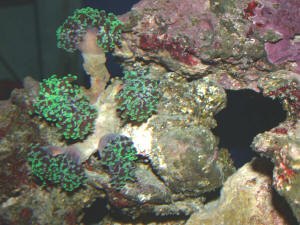
|
Fragging Euphyllia ancora - 01/05/06 Crew,
<<Bill>> Hope you are well. <<Yes, thank you>>
I have researched as extensively as I can on this site as well as web
based. <<ok>> I hope that you can direct me to the proper
link if I have missed it as I know you are all tremendously busy.
<<Tremendously <grin>...but seriously, what can I help you
with?>> I have a 8" expanded anchor coral. Not a hammer
coral, not a branching hammer coral; not a branching anchor coral. The
meandering structure type. Euphyllia ancora I believe. <<Does
sound like E. ancora, yes.>> I have three questions: 1) At what
point of growth and maturity on a segment is it safe to frag?
<<Hmm, not sure I get what you're asking. If you mean
"How big should the coral be before I frag it", then it
should be of a size big enough to produce a frag(s) of desirable size.
If you're looking for a "minimum" size, I think you could
get away with splitting a 3" specimen. Anything smaller and you
don't really have much to handle/work with. Of course larger
specimens could be fragged in to more pieces if desired.>> 2) How
does one frag this coral? <<Dremel tool...or a band saw.>>
All of the information on fragging that I have found is for the
branching variety. <<Is easier to frag.>> I have gotten
conflicting information; some state to simply whack the place where you
want to split with a hammer and chisel <<Messy and
wasteful...>> and others state wrapping a rubber band around the
skeletal structure and wait for the tissue to recede, <<This is a
good way to 'begin'.>> then whack it with a hammer and
chisel. <<But don't 'end' this way.>> To me,
this seems to be adding another level of opportunity for tissue
degradation, infection and just plan stress. <<The whacking?
Agreed>> And once split, what happens to the inevitable tentacle
that has tissue on both pieces - do you say "loves me not"
and jerk it on one side versus the other or will that be too damaging.
<<Never good to "yank" the tissue apart. If necessary
use "very" sharp scissors or a razor blade to cut.>> I
believe the rubber band/receding tissue suggestion has value but would
imagine it would be cleaner to use a circular saw or Dremel?
<<Yes on the rubber band method to recede the flesh from the
intended "break", this works quite well...but no circular
saw...much too dangerous. Buy/borrow a Dremel tool and a diamond bit.
This works very well for cutting the skeleton, just don't expect to
"zip" through it.>> Although the skeleton is quite
thick and dense. <<Very>> 3) I currently have this on a
raised substrate bed and it looks fabulous. However, I am concerned
about the frags I will have. Do I attempt to attach it with glue to a
small piece of rock for support and weight? <<This is
fine.>> Where on the skeletal structure would I accomplish that?
<<Mmm...probably opposite the fleshy bit.>> I would
appreciate your input. Regards, Bill <<You have it my
friend...EricR>>
Re: Fragging Euphyllia ancora - 01/07/06 Eric,
<<Bill>> Thank you. Just to make sure on a couple of points
and recap, if it is not too much bother. <<No bother at
all...>> ((I said)) At what point of growth and maturity on a
segment is it safe to frag? ((You said)) Hmm, not sure I get what
you're asking. If you mean.....get away with splitting a 3"
specimen. ((I will clarify :)) I meant at what point is it healthy to
pursue frag of this coral. (although, in reality, fragging is not
natural but beats harvesting). I've seen many people make quarter
inch Acropora cuttings. <<Difference in physiology.>> Each
segment seems to have a mouth (this is good, right?) <<And a
requirement.>> so my plan was to frag a segment when it reached
3" to 4". <<This sounds like a good plan...>> ((I
Said)) How does one frag this coral? ((You Said)) Dremel tool...or a
band saw. ((I Said Next)) Wow, that tough? I am assuming it is all
calcareous and there is no life aside from the tissue external to the
calcareous growth so I can hack away. <<Yep>> With the
proper tools how long should it take to go through 2 to 3" IYO?
<<Density will vary slightly depending on the coral and the water
flow conditions under which it was grown. With the Dremel tool I would
expect to take a minute or two to make the cut you describe.>>
New Question: Recommendations where/how to hold the tissue parts where
I will have to squeeze for leverage while cutting? <<Best not to
handle/squeeze the tissue...will cause damage. Handle the coral by the
skeleton...pliers may help with this.>> How long can it be out of
the water? <<A surprisingly long time it kept "wetted".
Keep a container of seawater handy and dip the coral frequently (every
minute or two) while working on it. Have another container of seawater
for placing the frags as they are cut.>> Would it be advisable to
do a bit, stop, then do more? <<I would get it all done at one
time...no need to extend/prolong the stress.>> I have never
allowed my corals to be out of water since I took xenia out for 8
seconds and had 2 pints of snot everywhere. Does anchor coral mucus or
slough easily? <<Expect some mucus, but not to the extent of the
xenia. I also recommend you rinse the mucus away before placing the
frags/parent coral back in the tank. Excessive mucus can be an invite
to bacteria.>> New Question: It is currently in moderate flow, on
a mound of sand in a raised grotto of rubble pieces, in direct
lighting. It has grown nicely and expands well - appears/seems to like
this area but I am not sure this is optimal or if it would do well
raised higher on a shelf. <<From what you say...I would leave as
is.>> I have about 5w per gallon of 10k/03 Actinic. Might be
interesting to see how the segments form with a different sense of
gravity. <<???>> My plan at this stage, barring additional
input from above. When retracted, place a wide rubber band around
segment (to give me space to work with in case of slippage) about
.5" to 1" from where the next segment meets. Allow time for
the tissue to recede, making sure that the tissue has reformed well on
the segment to be fragged and all sweepers are active and inflated as
normal. if not, I will watch for that and remove the band. I am going
to attach Styrofoam to the base and let it float in a plastic tray deep
enough for it to float, and work with the Dremel from the back side all
the way through if possible. If needed I will flip it and finish
exposed to air. I plan on also using the Dremel to smooth the edges
also. Then a mild Melafix and Iodine dip for both ends and back in the
tank. <<Don't think I would do the dip, many corals don't
react well in my experience. Possibly a mild iodine dip would be OK,
but I wouldn't mix it with the Melafix...just my opinion.>>
The frag will then be mounted to a piece of rock so it can be buried or
mounted. It has grown about .5" in the last month so I will be
doing at a couple of frags in another month or so at the same time - I
believe the rubber band method, if it works, will allow this to be
accomplished with very minimal stress. <<Agreed>> Take good
care. Bill <<Regards, EricR>>
Re: Fragging Euphyllia ancora II - 01/08/06
Apologies for being silly. <<Not necessary my friend.>>
>>>> I have about 5w per gallon of 10k/03 Actinic. Might be
interesting to see how the segments form with a different sense of
gravity. (<<???>>) I meant gravity in the sense of height
placement, lighting, flow as well as segment formation differences from
being on different structures instead of a flattish sand bed - curves,
dips, etc.. <<Ah, ok...a change in environmental
conditions...>> Thank you <<Regards, EricR>>
| Difficult parasite (?) ID/help question, Euphylliid
"thing" 10/9/05 [Hello! Resending this one because I
think there was a problem with the pictures file type. Thanks!] Hi!
I got what seems to be a sort of parasite on my hammer (ancora)
coral. I send you some pictures and give you some facts. I have
search the internet, asked people locally, and wrote to Mr.
Borneman but nobody can tell me what it is and how to get rid of
it. The "parasite" looks like a white tangled ribbon 2 to
4mm in length. Sometimes elongated sometimes as a ball. Looks
sedentary but does have some movement. They show mostly at night.
If you look at it with a flashlight they sometimes retract and get
back inside the polyp (within seconds). You can then see that the
polyp is punctured. It leaves a 2mm hole in the tip. These corals
heal quickly so you don't see those holes anymore during day
except for the occasional black dot (a scar(?)). It is always
located on the tip of the polyps, but anywhere on the tip (on the
"metallic green" part). The problem started on August
15th but until today the coral still seems healthy except for a few
deformed polyps (that were previously perfectly shaped). The
Heteractis Crispa anemone about 12" away from the infected
hammer coral started to have the same problem on September 16th.
Again only on the (purple) tips. I noticed once that two tentacles
were linked together by one of these ribbon like parasite. The
parasite was longer than usual, probably by the pulling effect of
the two tentacles. There is a branching hammer (parancora) less
than a foot from it but it is still not contaminated yet. Thanks a
lot in advance for your help! Dominique <Can't tell for sure
from the pix, but I believe these may be asexual buddings
(reproductive events) of your coral... Am still waiting to hear
back from Anthony re his opinion. Bob Fenner> |
|
 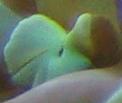 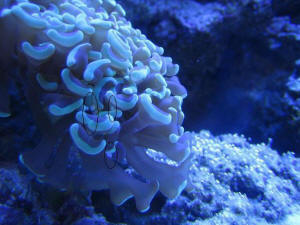
|
|
Re: Difficult parasite (?) ID/help question
10/11/05 Wow! I would never have thought. I am looking forward to
Antoine's confirmation but it's already a big relief to hear
this. <Don't know what... he's changing> Thanks! Since
it's so difficult for me to send a decent picture, would you know
on what website I could see pictures of that phenomenon. <Mmm, not
I... would ask Antoine and Eric Borneman on RC re> This way I could
visually confirm. I have been searching the internet after receiving
your reply but found nothing that would help. I guess the buddings are
drifting in the water and caught by the anemone and that's why I
see them there now. Just strange I never saw any piece drifting in the
water. <Bob Fenner>
Re: Difficult parasite (?) ID/help question
10/11/05 Hi Mr. Fenner! <<Don't know what... he's
changing>> Mmmm, wander what that means... <Wander/wonder?
Seems to me he's changing... not responsive...> I already wrote
to Mr. Borneman about it and the conclusion was that he didn't
think they were parasites but didn't know what they were and would
be curious to know. He advised me to do nothing. <Sounds about
right> I wrote to tell him your idea. I give you the link to the
thread in case you are interested:
http://www.reefcentral.com/forums/showthread.php?s=&postid=5874204#post5874204
(BTW they are not egg spirals because they move inside-outside the
polyps tips) Thanks!!! Dominique <There are other non-sexual
reproductive means... BobF>
|
Fragging Non-Branching Frogspawn - 09/12/05 Hi,
<<Hello>> I looked over your fragging FAQs, but I did not
get sufficient enough answers to my fragging question.
<<Really?>> I have a non-branching frogspawn, so it's
just one skeleton and one mouth. I bought it over a couple of months
ago, and it just started growing like crazy. <<That's a good
thing, ain't it?>> It is my favorite piece and I don't
want to get rid of it, but I do not know how to frag, and even more,
how to frag a coral that does not branch. <<Not all that
difficult really.>> Any help would be nice. Is there a site you
can point me to that can show me step by step on how to go about
fragging this gigantic frogspawn? <<A good friend of mine posted
a thread on Reef Central a bit more than a year ago that showed this
process...a key-word search might find it again.>> I have a 30
gal, and I swear, when it's fully out, it takes up about 1/4 almost
1/2 of the tank. Thanks in advance. <<Place a rubber band around
the coral transecting the polyps where you want to make the division.
After a week or so the polyps will recede from this point, allowing you
to cut the skeleton (a Dremel tool works great for this) without fear
of damage to the soft tissue. Regards, EricR>>
Shipping Clams
and Euphyllia Propagation 9.2.05 <<Anthony's
input>> Hello Crew! <Fred> You've been helpful with my
previous questions, and I'm hoping you may have some insights or
thoughts on a couple of quandaries that are pestering me tonight!
I've been shipping out clams lately via 2-day shipments (with 100%
success rates thus far!...knock on wood), <<FWIW... 2-day on
livestock in general is tolerable for some species, but not a good
habit at all. Especially in cases of additional delay or inclimate
weather>> and a recent "issue" got me thinking.
Generally these are clams in the 3-4" range that I ship out in
small 4x8" Kordon breathing bags. I would guess there's maybe
a cup of water in each one. I'm sure you're familiar with the
bags, so I won't go into detail. <Do know this Novalek
product> <<dreadful for shipping corals and spiny marine
fishes, of which there are many. Novel idea, but inherently flimsy to
be effective (breathing)>> Though every one has made it just
fine, the most recent shipment arrived in a broken bag and mostly dry,
though there was still moisture in the bag due to packing with a lot of
newspaper as well. This clam was also just fine upon arrival. <Are
very tough animals> This got me thinking: since the clams retain
water while they're closed up, would it make sense (or not?) to
perhaps wrap a rubber band around the clam so it would only be able to
open up a little? <Mmm, I would not do this> <<yes... what
he said. Yikes>> The last clam that broke through the bag has a
couple of sharp edges on its shell, and I'm sure it was the clam
opening up quickly in transit that popped the bag. <Or just it
rolling about> <<Agreed.. the clam opening did not do it...
the bags are weak and the shipping rough along the way>> I'm
not sure how long a clam can remain closed...I would assume there would
be some sort of breathing activity necessary? <Yes> I
wouldn't want to stop this during shipment (obviously). Your
thoughts? Is it a worthwhile method to attempt?? <Not IMO> My
second question is about Euphyllia propagation. We have two corals (E.
paradivisa and E. glabrescens) in our 24g Nano-cube that continuously
form buds around the base of the larger polyps. They eventually float
away never to be seen again... <?> <<the coral forms these
buds on healthy colonies and if the large polyp head above it is
damaged or chomped (often so in the wild), then there are ready and
waiting buds to grow if/when they are exposed to more light and water
flow. But when the polyps above it are large and healthy, the buds
abate (wax and wane really) or get aborted>> but I'm starting
to feel guilty about letting all these polyps go to waste! <I
don't think these are Euphyllia polyps> What would be the proper
way to collect and mount these? <<some aquarists carve them off
with a paring knife and let the tiny polyps settle in cups with tiles
or reef plugs). If the polyp is large enough, you can also handle it
with tweezers and super glue it with a dab upon rock>> There is
no skeleton on any of them that I can tell, so I'm not sure if they
would glue down very well. <<cup settlement for these>> My
other thought is some netting over a simple plug of some sort. I
consulted Anthony's book but wasn't able to find any specific
information on them. <I will cc him here re> The frogspawn alone
puts out 6-8 polyps a week or so, and I think these would be excellent
candidate for aquaculture if I can figure out a method to save and grow
them. << we demonstrate this in workshops if you make it out to a
hobby club conference... MACNA is coming up next in DC Sept 2005 (see
MASNA.org)>> Looking for a little insight on the subject if you
can provide any. Once again, many thanks! Fred <Bob Fenner>
<<Anthony Calfo>>
Re: Shipping Clams and Euphyllia Propagation
9/9/05 Hi guys, <Have sent your query along to Antoine as
well> I realize it's been a busy week, but I just wanted to
touch base to see if you had any more insights on these frogspawn
floaters...I'm letting a few every week go, hoping I can maybe do
something with them! Thanks! Fred <You did see Anthony's input,
archived here: http://www.wetwebmedia.com/clambizfaqs.htm He does think
these are offspring from your Caryophylliid> Subject: Hi Bob,
<Fred> Thanks so much for the help. I'll take your advice on
shipping the clams and won't mess with a good thing right now.
<Good> With regards to the Euphyllia, when you say you don't
think they're Euphyllia polyps, do you mean they're something
else completely, or not likely polyps? I've attached a picture for
you here. <Unfortunately, not here...> They are definitely from
the two Euphyllia corals, that much I'm 100% sure on. Well, after a
few pics, the best are attached (yet another argument for me getting a
macro lens!). I found one BIG piece in the back of the tank. Since I
never saw how it got there, I can't say whether it was pinched off
by something or extruded, or simply fell off. Your thoughts? <Could
be a "recruit" from your main colony... do break off...>
They're not the best pictures, but I think you should be able to
see the two polyp buds forming at the base of one of the larger polyps.
These are what seem to end up floating around in the tank, though now
maybe I'm not so sure after seeing the rather large piece in the
back. Can these buds be propagated successfully? <Yes>
They're maybe 2-3mm tall right now, and I can't tell if
they've got any sort of skeleton yet, but it intrigues me
nonetheless. BTW, the "baby polyp" picture is what appears to
be one of the buds. I know for sure it's from the Frogspawn, but
whether it's one of the buds (I know they're improperly called
anthocauli, but you get the idea) or simply a piece that came off, as I
theorized before. It would be wonderful if I could add these guys to my
current repertoire of Sarcophyton sp., various Zoanthids, Xenia, Cerith
snails, etc... Thanks again! Fred <Would "grow up" and
see... I had initially thought these were likely planulated
hydrozoans... now I'm more inclined to think they are asexual
buddings of the Euphyllia. Bob Fenner>
Fragging A Frogspawn - 08/23/05 Bob, <<EricR
here...>> I have a frogspawn coral in a 12G Nanocube reef that is
getting larger than I'd really like. <<ok>> My son
would love part of it to add to his 24G nanoreef, but I'm afraid to
try splitting it for fear of seriously damaging it. <<Little need
for concern if done carefully.>> I've looked through the FAQs
and can't find anything -- can you suggest how best to go about
"pruning" frogspawn? <<I can...have a look here through
our propagation FAQs and the related links re this coral (and others):
http://www.wetwebmedia.com/carypropfaqs.htm Thanks very much!
David Potter Hillsborough, NJ <<Regards, >
Fragging Non-Branching Hammer Coral - 07/06/05 I know you can
use a Dremel to cut the coral. But I have a hammer coral that isn't
the branching kind. I want to frag this coral but how would I use the
Dremel to cut along the top fleshy part of the coral. <<I have a
friend who does this. His method is to stretch a rubber band around the
coral crossing the polyps where he wants to make the cut. In a week or
so, the polyps will recede from this point leaving open skeleton for
you to make the cut without fear of damaging the polyps and risking
infection.>> Thanks, S. Montgomery
<<Regards, Eric R.>>
Frogspawn Bubbling Up Dear Crew <Mike G
with you tonight. I personally apologize for the delay in response:
our crew has been absolutely bogged down with queries for the past
week or so. I hope you understand.> My Euphyllia shown in this
picture is splitting on one of its colonies. However a bubble in
the coral flesh has formed on what seems to be the divide between
the splitting colony. Is this normal? <Absolutely normal for
splitting LPS. Happens all the time in my tank. Sometimes they stay
for quite a large period of time, but are nothing to lose any sleep
at all over.> It has been prevalent for about three months. The
coral has never been out of water and expands and feeds normally.
Regards
<Best of luck in this wonderful hobby, Mike G> |
|

|
Frogspawn and Torch Propagation 10/23/04 How would I go about
fragging a frogspawn or torch coral. I know everyone says to just break
the stalk; but on mine the problem is I have one stalk with 3 mouths on
the frogspawn and the torch has 1 stalk but 4 mouths. <if the polyps
have not completed fission, then you need to wait for them to form
separate "heads" with individuals "mouths". Then
you can use a Dremel rotary tool to saw them off anywhere from 2 CM
below the top edge tissue or lower> What would be the easiest way to
frag these 2 corals? <a Dremel is best/safest> Thanks, S.
Montgomery <best regards, Anthony>
-Dead portions of hammer- Hello again, I just have a quick
question for your fine staff. I have a three fingered HAMMER CORAL.
Unfortunately, one of the fingers seems to have died. Their is no sign
of life. However, the other two fingers are flourishing. Can I cut off
the dead finger or what would you suggest. <Absolutely, provided
there is no live tissue connecting the dead head to the live ones.>
Their is some brown slime starting to form on the dead finger.
<Definitely remove this dead one, it would also be good practice to
give the other heads an iodine dip, do a search on this site for info
how. Good luck! -Kevin> Thanks again for your hard work and
dedication, Jose
- Fragging - Hello again, I would appreciate your expertise
with a three fingered HAMMER CORAL. One of the fingers seems to have
died while the other two fingers are thriving. Is there a way I can cut
off the dead finger without damaging the other two. <Yes... with
needle-nosed pliers or I've seen some use tin-snips - just cut that
one arm as close to the base as possible. Should be no problem.>
Your assistance would be greatly appreciated. Also, would a lawnmower
blenny and a Kole Tang help with the removal of green hair-like algae
that is growing in may tank. <The blenny would likely help with some
of it.> I realized that my lights were on too long of a period.
Thanks for providing a great service to us, Jose <Cheers, J --
>
Hammer coral repair 3/3/03 hello Anthony, gang,
<cheers> Quick question for the ones with the answers. <we
make most of them up <G>> I recently bought a Branching Hammer
coral, upon placing it into the rockwork one of the branches broke off
of the coral. It did not hurt the coral cause it was far enough down,
<excellent... no worries at all then. Better for the polyps which
will grow faster now for getting better light and water flow> but I
would like to glue or epoxy the 2 pieces back to form one large,
beautiful coral that it was. <if you like> Any detailed advice on
how to go about this would be great. <wave the polyps in (fully
retracted) then lift the branches out of the water to protect the
tissue from abrading against its own sharp septae. Pat/blot both broken
edges dry with a towel... glue with thick super glue gel (any brand)
and tie the branches together with a tight rubber band (will dissolve
in weeks) or a plastic cable tie (you cut away the next day). The coral
can stay out of water for a couple minutes if you like to finish
this> I just got your "Book of Coral Propagation" Anthony
, its awesome and is very informative. thanks all for everything.
<thank you kindly, my friend. Anthony>
| Baby Bubble coral? 3/10/03 Hello again,
<cheers> I have never seen this before but will ask for your
opinions, Mr. Calfo and Mr. Fenner. Before I bought this green
bubble coral I asked if there was any recession of the tissue or if
the coral was stressed at all. Since it was on the internet
that's all I could do. <indeed... the pitfalls of buying the
unseen> I was told there was no recession of the tissue and that
the coral wasn't damaged at all so I bought it. Well go figure,
when I got the guy over two months ago lo and behold there was some
recession of tissue but no broken skeleton anywhere. <no
biggie... rather common on stonies with such large and exaggerated
septa. Probably could have been packed better though (using folded
plastic in the bag submerged as bumpers)> I have had the bubble
in quarantine since I received it and have been trying to bring it
back to health. <feeding will be key... tiny portions several
times weekly here> The tissue has receded more than when I got
it buy yesterday noticed and small bud on the side of the skeleton
or what I think is a baby bubble coral. <correct... an asexual
bud. It is completely separate from the parent and can be removed
in time> Looks like it is anyway, during the day the tentacles
have enlarged bubbles and at night the tentacles don't resemble
bubbles at all but long skinny tentacles. It is about the size of a
small pea. I am sending pics for you to go over. What do you guys
think? Is this a baby bubble or just an anemone? <it is a bud
off the parent coral> How do I go about feeding it? <just
stirring the sand or detritus near it at night will serve you for
months until it gets larger> All help is needed so I can care
for this guy. Thanks, Jeff <in time, use a rotary tool to saw it
away from the parent and then glue it to a hard surface. Else, it
will die in the shadow of the parent assuming the parent recovers
and thrives. Kindly, Anthony> |
|
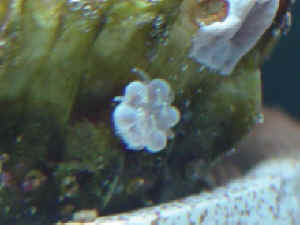
|
Frogspawn Coral Budding 3/5/03 Hello, I hope all is well.
Firstly, I would just like to thank all of the crew for their help both
directly to myself and through reading the FAQs. <and thanks to you
for caring and helping yourself/our hobby> I have just one question
tonight, I noticed a small bud on the skeleton of a frogspawn I have
had for several months. <wonderful> It is about the diameter of a
pencil eraser fully extended. <in time it will need to be removed or
it will die in the shadow of an older "head" polyp. In the
wild, these are started for if/when the big polyps get
eaten/destroyed> My question is does the frogspawn translocate
nutrients within the colony from feedings, <alas, no... each polyp
must be fed> and if so, will this suffice the new polyp given that
it is fairly obstructed from the light? <as per above... needs fed
and needs to be removed in time> Thank you again for your never
ending assistance to all. Ed in NJ <with kind regards,
Anthony>
Frogspawn Hi guys. Question about frog spawn. I have one with
four branches, one branch is dead. Can I trim this off or should I
leave it alone. <Either, but I would leave it. It is possible that
the dead branch could become live again. We just had a similar question
and report the other day. You can read about it here
http://www.wetwebmedia.com/caryfCorlsaqs.htm> Are they long lived
creatures? <Can be very long lived as long as they do not fall to
predation or infection.> Thanks! -Becky <You are welcome. -Steven
Pro>
Frogspawn & Another Possible Anthocauli You answered a
frogspawn question on 6/23 and indicated that a "dead" branch
on a frogspawn would never grow again. This was my understanding as
well, but one of the "dead" branches on mine has spouted two
new animals! Was this branch asexually recolonized by another living
branch? <Probably not. If there was an asexual spawn, much greater
likelihood of landing on the rock.> Or was there some remnant of the
previous animal that returned? <Perhaps another coral that produces
Anthocauli.> There may not be an answer to this, just wanted to get
your hunch on it and report a small success! By the way, the new
frogspawns appeared about 4 months after the branch died originally.
They are growing like weeds! For reference purposes, the coral sits at
a depth of 14" in a 72g with 85 lb LR and DSB. Lighting is 2 175w
MHs and 130w actinic PC. I have a 20g sump with an AquaC EV-120 and no
other filtration except GAC in sump. Temperature is 80, salinity is
1.025, pH is 8.4, alkalinity is 3.5 mEq/l, calcium is 450 ppm, no
detectable phosphate, nitrate, ammonium, or nitrite. I also use a
wavemaker. Thanks -Ed. <Do look up the article by Anthony and I
concerning Anthocauli production. I think there are probably many
"dead" LPS corals that can come back to life if given time
and proper conditions. -Steven Pro>
Re: Frogspawn & Another Possible Anthocauli II Thanks for
the response, Steven. I did look up your article and learned something
new! The two baby Euphylliids are about dime-sized at this point. I
actually have a friend with a declining brain coral (partially denuded
skeleton), so I will let him know that he shouldn't give up on it.
<Yes and take pictures of both corals, too.> Also, you can tell
Anthony that I ordered his book. I'm looking forward to it because
I think I've read through Borneman's book about 3 times by now!
<Anthony's book is excellent! You will be very happy with your
purchase.> Thanks again - Ed <Talk to you later. -Steven
Pro>
Frog Spawn & Plate Corals Hi. I have a question about a
frog spawn I bought. It has four "branches" to it. Three are
beautiful, one is just a dead skeleton. Will the branch grow in again?
<No> One more thing. I have a plate coral that you guys have been
yelling at me for the way I was treating it. Just wanted to let you
know that it is on the sand now and I bought a 175 watt MH to make sure
it's receiving enough light. I'm not a coral killer, I swear!
Does the sand have to be the real soft kind or can it be aragonite
sand? <I do not know what you mean by soft sand, but aragonite is
best.> I have aragonite. Thanks! -Becky <You are welcome. -Steven
Pro>
| Anthocauli? Simply Budding Hey Anthony -
just wanted to send you a shot of the anthocauli on my frogspawn.
There are 2, but one is more visible (top left). This shot is
obviously at night, but during the day they reach about the size of
a quarter now. Ed Marshall, Austin, Texas <absolutely awesome my
friend. Thank you so much for sharing. It reminds us to never give
up too on injured or damaged animals :) A little schooling too:
anthocauli most only refers to Fungiid satellites. In some other
Scleractinians (Lobophyllia and Trachyphyllia, e.g.), clones seem
to form similarly between the septa (the "ridges" of a
large corallite) via decalcification of the parent. In your coral,
the fissionary bud is not forming from between the septa and
perhaps not even from de-calcification. It seems to simply (and
wonderfully) be an event of budding. Ughhh.... sorry for the
scholastic/academic bone picking :) But I'd to let it pass my
without sharing the information. By any definition... it is great
to see! I bet if you wait some months and beak it off, more will
follow. Do separate with a Dremel if you do. Best regards and be
seeing Texas soon (September), Anthony> |
|
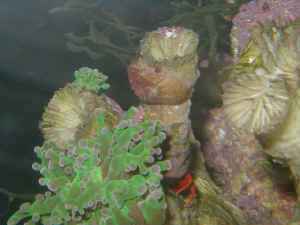
|
Bubble corals Hello again, I recently purchased a bubble
coral from my LFS. My question is, it looks as though the coral was
damaged in transport and now it looks to have split into 2 equal sized
halves. It doesn't look as though there is any more damage. What
should I be looking for and if it is not damaged to severely, will
these two parts grow into two healthy bubble corals? Looking forward to
your input, you have really helped out in the past. <If not too
damaged this specimen (Plerogyra) will/should recover... most important
here is to provide a stable, optimized environment... resist trying to
move the animal/colony, and consider adding enough current to keep
"dust" off of it. Stony corals are slow to come back, but do
so if not too beaten, given good circumstances... Bob Fenner,
www.wetwebmedia.com>
Frogspawn question I've had a frogspawn for about
two weeks and its doing fine. however its a subspecies of frogspawn
that actually branches off and each branch has a cluster of polyps on
it. its not like the 'usual' frogspawn that has only one polyp
cluster. anyways.... there are five polyps on the coral and one is
dead. I got it this way and I was wondering if there was a chance that
it would regenerate a new polyp. Lemme know what you think. Jon
Trowbridge <This is likely Euphyllia glabrescens... maybe take a
look at the family Caryophylliidae pix on the www.wetwebmedia.com site,
and the associated FAQs pages... And yes to the likelihood the
"missing" branch will become repopulated... with time, good
conditions. Bob Fenner>
Torch coral reproduction? Hi Bob! I just wandered how do
torch corals reproduce? Is it by budding? <Yes, in a manner of
speaking... as well as sexually> Looking at my tank in and endless
stare as usual a saw a very small what I assume (bud) of a torch coral,
just like the tip bright yellow almost a perfect sphere, looks like it
just pinched off. If this is a form of reproduction is there anything I
can do to help this lil bud to make it? <Keep the system stable and
optimized is about all> I found it sitting on my Brain coral so I
moved it to a piece of live rock and it seems to be sitting there for
who knows how long, I am afraid it may be gone in the morning. Any info
would be greatly appreciated on how Torches reproduce. Also can these
corals be propagated? <Yes, most often done by way of hand tools,
breaking off a piece, adhering or propping them up toward the light,
good current, boosted alkalinity, biomineral content in their water...
some folks do this in a tied-in sump with their main systems. Bob
Fenner> Anxiously awaiting more knowledge than I have Robert
Huss.
|
|

